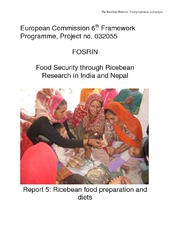| dc.description.abstract | The existing scientific literature has established that the nutritional value of ricebean (Vigna umbellata) in many respects is impacted by different methods of food preparation. In particular, antinutritional factors such as phytic acid, tannin and trypsin inhibitor, and the content of indigestible saccharides are reduced considerably if the beans are subject to common, low cost, pre-cooking and cooking procedures. The effects of overnight soaking, sprouting, de-hulling and pressure cooking all tend to reduce anti-nutritional factors, and in effect make the important micronutrients more bioavailable and the beans more digestive. Field evidence shows that the widespread use of pressure cookers for common preparations of ricebean is, unfortunately, leading to widespread neglect of soaking and sprouting. The evidence in scientific literature clearly suggests that a combination should be advocated, for ricebean as well as for other grain pulses. The most common preparation of ricebean in both India and Nepal is as dhal, a soup or sauce which is served with a staple of rice, wheat or maize, and various vegetable curries in addition to dairy produce. However, ricebean is also served using a number of other recipes, including mixed bean sprout soup, ricebean stuffed items, and grinding soaked ricebean into a paste to make various shapes of deep fried nuggets. Many of these recipes are existing local ones, and field demonstrations show that ricebean is a versatile raw material which can substitute other pulses in common recipes that are locally popular. Thereby, ricebean has potentials when it comes to value added products which can be produced at a local market place and tea-shop level. The field evidence also shows that there are large variations in the diets in different sites, both in terms of staple composition (the balance between rice, maize and wheat) and the consumption of different grain pulses. In the four areas in the nutritional survey, ricebean was recorded as the sixth most common grain pulse. | en_US |

